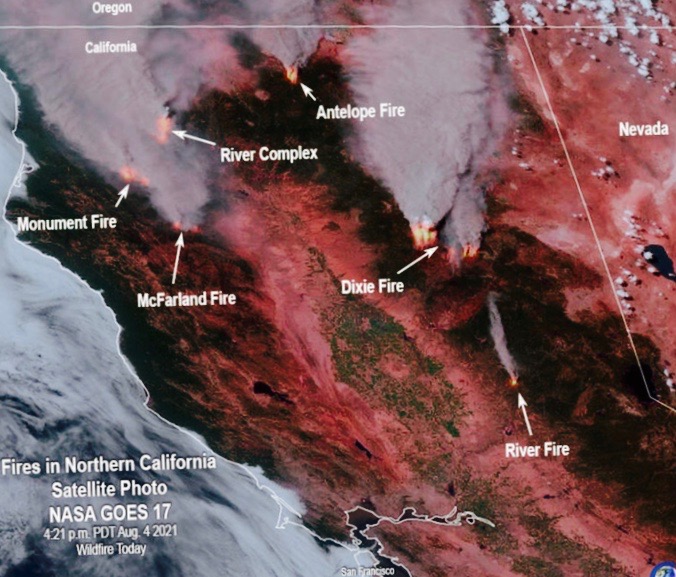California fires cause mass destruction across the state, new blazes threaten communities
A NASA map of the the Caldor fire. Fires like these have caused mass destruction across California.
Wildfires have engulfed most of Northern California in flames, spreading across 1.2 million acres and five different counties. Two main fires –the Caldor Fire and the Dixie Fire — have set records in both expansion and longevity. Incoming weather conditions have intensified the effort as firefighters work to contain the blaze.
The Caldor Fire sparked on Aug. 14, with the initial cause under investigation. It has burned more than 214,000 acres across three counties. For a few weeks, it was the most concerning of the blazes, but firefighters have been able to make significant progress. Currently, about 50% of the blaze has been contained, allowing some evacuation orders to be lifted.
As concern over the Caldor Fire decreases, the Dixie Fire has taken over as the dominant fire. In the three months since it started, the fire engulfed nearly 930,000 acres, making it California’s second largest wildfire in state history. Firefighters have managed to contain about 60% of the blaze, but weather and its continued spread have put more communities at risk.
This past weekend’s forecasted weather conditions threaten the containment of the blazes. Incoming wind and dry lighting increase the possibility and speed at which the fires could spread. Combined with already-dry conditions, the National Weather Service warns of “extreme fire behavior.” There was a glimpse of hope on Thursday (Sept. 9) evening as rain fell over some of the blaze. However, most regions received less than an inch of precipitation. According to Daniel Berlant, assistant deputy director at Cal Fire, “three inches in a short period of time” is needed to even slightly douse the flames.
According to the Cal Fire, fires have burned nearly 2 million acres of land, damaging 3,050 structures, and caused one death. Most of the more severe incidents occurred in Northern California, where vegetation is denser, causing the fires to spread quicker. Certain populations are at higher risk of being displaced or harmed by the fires. Direct Relief lays out five key factors that may impact a community’s vulnerability: poverty level, age, access to a vehicle, housing density and disability. If a county scores higher on those tests, it is more likely to be negatively affected by wildfires.
Over the past few years, the American West has witnessed a drastic increase in wildfires. In 2020, more than 10.6 million acres burned across the western half of the United States. Not only are they getting bigger, fires are also becoming faster, more frequent, severe and destructive. NASA attributes this development to climate change. As the earth warms, dry seasons prolonged, causing vegetation to wilt, which provides kindling for wildfires. As the frequency and severity of heat waves and droughts increase, fire season is starting earlier and ending later.
So what can we here on the Hilltop do? Numerous organizations have created donation funds to help families who have been affected financially, including the Salvation Army, the Red Cross, and the California Community Foundation.







